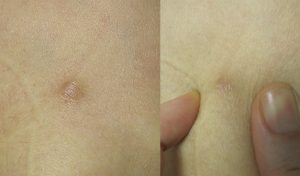Maybe you’ve seen a little brown bump on your legs or arms, reminiscent of a scar, ingrown hair or mole. Sound familiar? These lesions are called dermatofibroma, and I will talk about it in today’s article.

WHAT IS a dermatofibroma?
Dermatofibromas are very common benign tumors (again, meaning by “tumor” simply “lump”, without meaning it is malignant or anything similar), which are usually harder than normal brown skin. It is not uncommon for a person to have more than one on their legs or arms.
More images of dermatifibromas
They are firm to the touch and in many cases are not bothersome, although some people find them slightly painful, especially when squeezed. They are usually less than a centimeter in size, although sometimes larger dermatofibromas occur.

They appear more frequently in adults, usually on the legs. They are twice as frequent in women as in men.
WHY do dermatofibromas occur?
Traditionally, they have been blamed on small wounds, bites, or ingrown hairs. If you have any, you have probably thought that was the cause. However, as with so many things in dermatology, the cause is still not entirely clear.
Are dermatofibromas RISKY?
No. Dermatofibromas are benign and have no chance of turning into something bad.
How are dermatofibromas DIAGNOSED?
They are usually diagnosed with a simple examination. Dermatofibromas characteristically show what is called the pill sign. This means that when they are squeezed from the side, they become depressed and sink into the skin, as you can see in the picture.

When pressed laterally, dermatofibromas are slightly depressed.
In any case, dermatofibromas can have very varied aspects and colors, so sometimes it can be difficult to differentiate them from melanocytic nevi, basal cell carcinoma, certain scars or even melanoma. To differentiate them, the dermatologist will use the dermatoscope and if this is not enough, he/she may indicate that they should be removed to confirm the exact diagnosis.
How are dermatofibromas TREATED?
From a medical perspective, once the diagnosis is confirmed, no treatment is needed for dermatofibromas. They are usually removed under two circumstances: if they are painful or for cosmetic reasons. In rare cases, as I mentioned earlier, they may need to be removed to confirm the diagnosis.
To remove them, local anesthesia is used; small punctures are placed in the area of the dermatofibroma to render the skin insensitive. After removal, stitches are usually given. It is important to keep in mind that in the area where the dermatofibroma was, there will be a scar, so it is not always compensated to remove them for aesthetic purposes.
